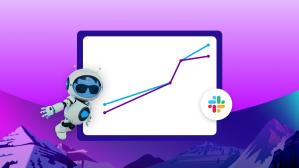Quick Take: Demand on IT teams continues to rise. Companies that learn how to empower their business teams to deliver digital innovation will thrive in a digital-first world.
Today’s digital imperative requires companies to increase output to stay ahead, but only 25% of IT leaders say their current technology maximizes employee productivity. And as demands on IT teams continue to rise, employees need to be empowered to unlock data and automate integrations more quickly.
Last month, we announced MuleSoft Composer for Salesforce, which allows business teams to securely automate integrations to create connected experiences and quickly launch digital projects – without writing any code.
We sat down with Liam Doyle, SVP, Product Management and GM for MuleSoft Composer to discuss how empowering business teams will change the way people work, the role of automation in digital transformation, and his prediction for the next big advancement in digital innovation.
Q. How important is it for organizations to empower all teams across the business to innovate?
The pandemic has fundamentally changed how quickly businesses adopt new digital initiatives. In fact, McKinsey data shows that digital transformation has accelerated by seven years.
The problem is that as every company moves to a digital first strategy, IT teams aren’t growing fast enough to meet all of the demands coming from customers and employees. We call this the IT delivery gap.
In our latest research, 82% of business users say they need access to data and business workflows in order to do their job effectively. So, to help IT keep pace, we are solving for the IT delivery gap by empowering the rest of the business to innovate alongside IT.
As Simon Bocca, Founder of cloud payroll solution PayCaptain shared at a recent MuleSoft event, “IT has the potential to move from being the custodian of innovation to becoming the inspirer of innovation“, which is a major, positive change.
Q. How do you see automation playing a role in digital transformation?
Shrivathsa Ballal, Chief Technology Officer at WatchBox explained it really well at Leading Through Change a few weeks ago. He said that it’s just not possible to deliver the type of connected experiences that customers and employees are demanding — especially when they are working from anywhere — without having trusted automation in place.
Trusted automation relies on having a single source of truth, and getting the right data to the right employees so that companies create the type of immediacy and collaboration that enables them to deliver delightful customer experiences. These seamless experiences are what customers demand, and are critical to staying relevant and competitive.
Again, PayCaptain is a great example. The cloud payroll company uses automation to turn payroll into an agile process that puts employees in control of how they receive their pay. This is only possible if you have automation to ensure that all account and payment information from disparate sources like HR and Payroll systems are available to those employees in real time.
Q. What are some of the challenges businesses face when automating integration?
The first challenge is trust. Once you’ve solved for that, the second challenge is that IT delivery gap, and empowering everyone to innovate.
Trust in this context means ensuring that integrations are reliable, scalable, and that they protect privacy and security for both individuals and organizations. As we move to automating more and more processes and integrations, it’s mission critical to be able to maintain this trust at scale – with the least amount of human involvement and validation.
Empowering more teams in the organization to innovate is also critically important, especially if you want to keep pace with the change that’s happening in the market. This requires giving business teams access to technology that enables them to automate more of their day-to-day work, while still allowing governance and control from IT. If automation and integration remains with IT, companies are essentially limiting their ability to innovate more broadly.
Q. How does Mulesoft Composer for Salesforce help solve these challenges?
Built on our trusted Anypoint Platform™, MuleSoft Composer for Salesforce is the first and only integration solution that’s embedded in the Salesforce platform. It helps business teams automate all of their integrations and deliver innovation faster than ever before.
For example, sales operations teams can easily and automatically connect apps and systems to Salesforce, automate sales processes, and unlock richer sales insights by leveraging a library of pre-built connectors, including NetSuite, Workday and Slack. Then, as Salesforce admins, they are able to access the data instantly from core systems — without developing any new code.
As we move to automating more and more processes and integrations, it’s critical to be able to maintain trust at scale – with the least amount of human involvement and validation.
Liam Doyle
Q. How will MuleSoft Composer for Salesforce change the way people work?
This is the first time that Salesforce admins will be able to automate complex integrations from within the Salesforce platform. They can trigger these automations from Salesforce events, but critically, they can also trigger from events in third party systems themselves. Not only that, but they will be able to orchestrate these integrations across many systems in one flow. This is what really opens up incredibly powerful use cases.
Imagine doing a daily integration of data from Salesforce to Tableau and then sending a message to everyone on the team to tell them it’s ready. These kinds of multi-system orchestrations have just not been possible before, and they ultimately solve two problems: Getting data where it needs to be, and enabling those connected experiences that admins are excited to deliver without having to bring in external developer resources.
Q. You mentioned you led a discussion with some industry leaders a few weeks ago. Any takeaways you’d like to share?
One comment that really struck me was from TAB Bank President Curt Queyrouze, who shared how organizations should be thinking about the unmet need that is underlying customer behaviors, the “jobs to be done.”
As we were talking, Curt illustrated how this works really well across TAB Bank and PayCaptain. When a banking customer is logging in to check their bank balance, and then logs in to their payroll system to view the next payment cycle, the customer may not care about these interactions independently. Rather, they are trying to establish when they can buy a birthday present for their partner.
When we take a “jobs to be done” perspective on our customers, we can identify these hidden requirements, and they often demonstrate how more than one system (from more than one company) is required to get that job done. This really underscores the importance of integration, and also shows why so many companies are creating partner ecosystems around their core businesses.
The other takeaway that stuck with me was from Justin Reis, co-founder and Global CEO of WatchBox.
Watchbox is a luxury watch retailer, so his customers are used to a very high touch customer experience, which doesn’t naturally translate to digital. Additionally, he also wanted to empower his sales teams to be entrepreneurial and be able to deliver the appropriate experience in each market that they operate in.
So, Watchbox had to make consistent data available to both the customer and the employee in real-time, wherever they were in the world. And they had to automate all of their processes to ensure that these independent business units could operate without central control, following the sun from Singapore to London.
Q. What advances do you expect to see in digital innovation post-pandemic?
As we imagine our lives beyond the pandemic, the big question will be, “what digital innovations will stay once we return?”
Everyone has a prediction, but here at Salesforce and MuleSoft we believe the need to enable success to happen from anywhere, as customers and employees will continue to seek amazing digital-first experiences that are connected from end-to-end, is a trend that’s here for good.
To support these digital innovations, organizations need to seamlessly orchestrate their people and their systems. Collaboration can help with the former, and we are here to help with the latter.
If companies can better automate and integrate their disparate apps and systems, and start to empower the entire business to be part of this innovation, they will be on path to move quickly and deliver new customer and employee experiences at scale. A strong collaboration between IT and the business is foundational here, so the company can keep pace whilst still building and maintaining trust with these customers and employees.
More Information:
- To learn more about the recent announcement, check out the press release here.
- For details on Mulesoft Composer for Salesforce, visit our website.
- Register for our upcoming keynote event “The future of sales automation and integration with MuleSoft Composer” on April 15 at 10 AM PDT.
- Head over to Trailhead to learn why empowering teams across the organizations with integration is critically important to the success of digital transformation.















